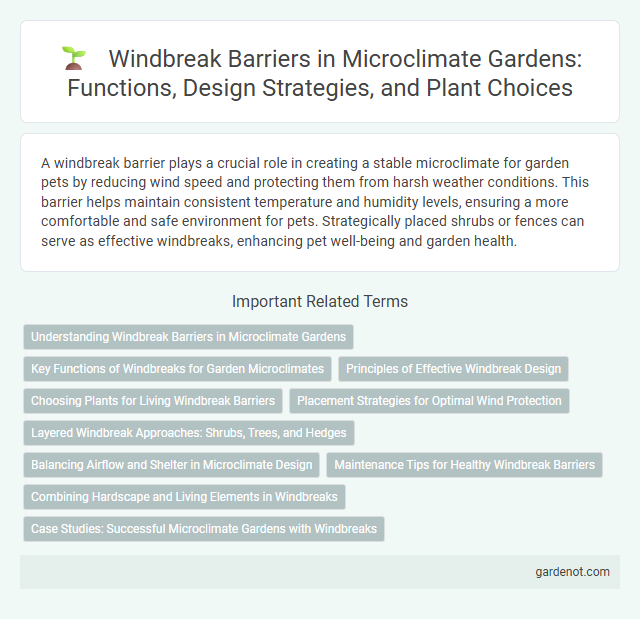A windbreak barrier plays a crucial role in creating a stable microclimate for garden pets by reducing wind speed and protecting them from harsh weather conditions. This barrier helps maintain consistent temperature and humidity levels, ensuring a more comfortable and safe environment for pets. Strategically placed shrubs or fences can serve as effective windbreaks, enhancing pet well-being and garden health.
Understanding Windbreak Barriers in Microclimate Gardens
Windbreak barriers in microclimate gardens reduce wind speed, creating sheltered zones that promote plant growth and conserve soil moisture. Strategic placement of fences, shrubs, or trees can modify airflow, improving temperature regulation and reducing evapotranspiration. Effective windbreak design enhances microclimate stability, supporting healthier ecosystems and increased crop yields.
Key Functions of Windbreaks for Garden Microclimates
Windbreak barriers significantly reduce wind speed, creating a calmer microclimate that protects plants from desiccation and physical damage, enhancing growth and yield. They help retain soil moisture by minimizing evaporation and reduce temperature fluctuations, stabilizing conditions for sensitive plants. By controlling airflow, windbreaks also prevent frost damage, supporting a more resilient and productive garden environment.
Principles of Effective Windbreak Design
Effective windbreak design requires placement perpendicular to prevailing winds to reduce wind speed and prevent soil erosion in microclimate gardens. A combination of dense, multi-layered vegetation with varying heights optimizes air turbulence control and enhances wind diffusion. Proper spacing between tree rows and hedge densities ensures optimal porosity, balancing wind reduction without creating detrimental turbulence effects.
Choosing Plants for Living Windbreak Barriers
Choosing plants for living windbreak barriers involves selecting species with dense foliage and sturdy structures to effectively reduce wind speed and protect microclimates. Evergreens such as arborvitae, spruce, and juniper provide year-round protection, while deciduous shrubs like dogwood and hawthorn contribute seasonal adaptability and biodiversity. Proper spacing and layering of tall trees, mid-sized shrubs, and ground cover maximize wind resistance and promote a resilient garden ecosystem.
Placement Strategies for Optimal Wind Protection
Effective placement of windbreak barriers involves positioning them perpendicular to prevailing wind directions to maximize wind resistance and reduce wind speed. Maintaining appropriate spacing between barrier rows allows airflow control without creating turbulence that could disrupt the microclimate. Incorporating varying heights and densities in the windbreak design enhances protection by creating layered wind reduction zones tailored to specific garden needs.
Layered Windbreak Approaches: Shrubs, Trees, and Hedges
Layered windbreak approaches in microclimate gardens combine shrubs, trees, and hedges to effectively reduce wind speed and create sheltered environments. Dense shrubbery at the base, mid-height hedges, and taller tree rows form multiple protective layers that trap and diffuse wind energy. This strategy enhances plant growth, reduces soil erosion, and improves overall garden microclimate stability.
Balancing Airflow and Shelter in Microclimate Design
Windbreak barriers in microclimate garden design optimize plant growth by strategically balancing airflow and shelter, reducing wind speed without causing stagnant air zones. Selecting porous materials like mesh or semi-permeable screens allows filtered airflow, preventing excessive humidity and promoting healthy transpiration. Proper placement and height consideration ensure protection from prevailing winds while maintaining sufficient air circulation to regulate temperature and moisture levels effectively.
Maintenance Tips for Healthy Windbreak Barriers
Regular pruning and removal of dead or diseased branches improve airflow and promote the vitality of windbreak barriers in microclimate gardens. Ensuring proper irrigation prevents drought stress, while mulching helps retain soil moisture and suppress weeds around the base. Regular inspections for pest infestations and timely treatment with organic insecticides contribute to the long-term health and effectiveness of windbreak plants.
Combining Hardscape and Living Elements in Windbreaks
Integrating hardscape features such as fences and walls with living elements like shrubs and trees creates an effective windbreak barrier that enhances microclimate control in the garden. This combination not only reduces wind speed and soil erosion but also improves air quality and biodiversity by providing habitats for beneficial insects and birds. Properly designed mixed windbreaks optimize space use and aesthetic appeal while offering year-round protection from harsh winds.
Case Studies: Successful Microclimate Gardens with Windbreaks
Case studies of successful microclimate gardens demonstrate how strategically placed windbreak barriers, such as dense hedgerows or permeable fences, reduce wind speed by up to 70%, enhancing plant growth and soil moisture retention. Research from the University of Minnesota showcases a windbreak system increasing crop yields by 15-20% in cold, windy regions. In coastal California, microclimate gardens protected by native shrub windbreaks report significantly lower evapotranspiration rates, contributing to water conservation and improved microhabitat stability.
Windbreak barrier Infographic

 gardenot.com
gardenot.com